MBU-5/P oxygen mask
Latest update 29 December 2006
Message 114, 8 December 2003
Hi there Bluelight and group,
What you have there is a custom fit type of MBU-5/P mask...In this type, a dental cast is
taken of the face in question, and as I was told by one who was thus fit, the mold went to
WPAFB. In return, the pilot recieved 3 or so "custom " fit face pieces for
current/future use. Even though the MBU-5 might fit some, better than the other masks,
seems that it was not enough in some cases.....the fellow I met who had one fit was
callsighn " Bison " This was most likely because he had a face that only a
mother buffalo could love :)
The facepiece will have an ID number and the pilots name molded into it. Also, it fits
loose in the shell and tends to "fall out " when not worn, but looks very
functional non the less. The shell is made of a much more durable and flexable plastic
than the standard MBU-5, and from that standpoint alone, would be a plus.
Hope this helps. All the best to the group ! Milehigh
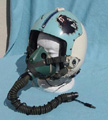
Custom fit version of MBU-5/P oxygen mask
fitted to a custom fit HGU-2A/P helmet
© airforce1944
Message 111, 7 December 2003
Hi all,
I guess that you have all seen eBay seller airforce1944's auction for the gorgeous light
blue P-3 helmet T.O. modified to P-4 standard but that is not the reason for my posting.
If you scroll all the way to the end in that auction you will find a picture of an
HGU-2A/P with light blue visor housing. I cannot identify the oxygen mask in that picture.
Is it an MBU-5/P variation, an MBU-7/P, or something else? In case you read this posting
online after the auction has disappeared from eBay the picture is also avaliable below.
Cheers, Bluelight
Message 1448, Mar 2, 2001:
This item just ended its eBay auction (went for $46, or thereabouts). It appears at first
glance to be a strange or somewhat modified MBU-5/P, but it is possibly a rare MBU-7/P
(note suspension fittings, characteristic of the MBU-7/P shell & straps arrangement).
Anyone have any 'best guesses' on its true ID? (See attached Sierra Engineering sheet on
the MBU-7/P, also; the MBU-7/P mask is the one on the right side.) If this is in fact an
MBU-7/P, "ceikberger" got himself an exceptionally great deal! Cheers, DocBoink.
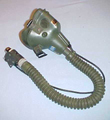
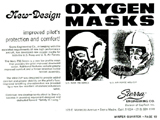
Message 1253, Feb 14, 2001:
Hello Steve N. and all, I've attached images of an MBU-5 with the Christmas tree type O2
connectors per the query from yesterdays discussion. The coms should be clearly visible.
Hope this helps guys. Other things of note are the rivet reinforcement of the straps of
the mask ( at the cross over on the nose ), and the repositioning of the mask receivers on
the shell. Steve Vallejo
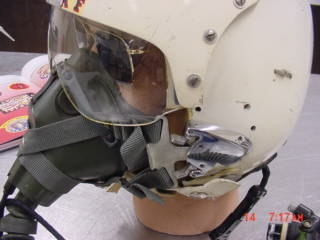
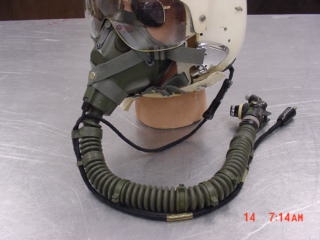
Message 903, Feb 1, 2001:
Hi Bluelight14, Thanks for the interesting shot of the Danish F16 jock wearing an MS22001
with Hardman kit suspension. Actually, the MS22001 mask is deemed relatively comfortable
by many former users, although the cross piece that is situated at about upper lip level
seemed to present some discomfort for those who had moustaches (RAF types, I guess). The
MBU-12/P (and its USN variants) was developed specifically to provide greater wearer
comfort, improved downward peripheral fields of vision, and substantially enhanced
face-seal for high pressure/high-G situations. Imagine the chagrin of the USAF's Aircrew
Systems Lab when it performed a study comparing face-sealing efficacy between the original
MS22001, the MBU-5/P, and the MBU-12/P, some time ago and found that the vaunted
"improved design" MBU-12/P was actually more prone to high-G face-seal leaks at
high pressure rates that either the MS22001 or the older MBU-5/P. It is ironic that while
the MBU-12/P and its variants are more 'desirable' to collectors (as newer gear), the old
MBU-5/P mask actually sealed more completely in many comparative tests. Check out the
relatively high value of HGU-55/P and MBU-12/P sets that appear on eBay: they just seem to
have a 'sexier' cachet or collector appeal for many people than the old reliable MBU-5/P
(that continues to soldier on) attached to an HGU-33/P or HGU-26/P. Cheers, DocBoink
Message 530, Nov 13, 2000:
Now that you mention this, I recall other sources referencing the fact that the MBU-5/P
was favored as an more suitable alternative to the MBU-12/P type mask due to face seal
problems encountered with the latter mask within certain percentile parameters of the
face-fit envelope. I subsequently conducted some face seal tests of my own on the MS22001
silicone mask, the MBU-5/P mask, the MBU-12/P mask, and the TLSS type MBU-20/P precursor
mask a while back and found that I also had face seal pressure problems at normal delivery
rates of pressure-demand atmosphere (I used air room instead of 02). The MBU-12/P type
mask has shown itself to be less than favorable when used by certain facial conformation
types, a situation that was probably somewhat embarrassing to USAF and USN anthropomorphic
test engineers well after the mask came into standard service use. The newer MBU-20/P type
(and HA/LP) masks provide far better face sealing than the MBU-12/P type mask--this is
particularly true during high-G or ACM maneuvering, when G forces tend to induce or
magnify existing distortion at face/mask seal periphery. Cheers, Chris
Message 519, Nov 12, 2000:
Very early MBU-5/P masks (especially those dated 1959 and 1960, or so) did not feature
inhalation/exhalation valve hose extensions (straight tube extending from the mask's valve
into the upper part of the hose by about 1 inch). Thus, the hose end that was attached to
the valve was not protected from extreme right angle bending. The result was that the hose
could become crimped at this juncture, dependent upon unfavorable head-motions of the
wearer. The problem was corrected by extending that extra 2.5 cm of length to the
inhale/exhale valve and most early masks were upgraded in this manner with the newer
valve; there are a number that were not, since they turn up now and then, and it is
presumed that this was because they were withdrawn from service before the TO update could
be undertaken. I have never been able to find much actual TO information on this matter in
terms of USAF data. Anyone else out there have an additional insights into this particular
aspect of the early MBU-5/P mask valve-hose subject? Cheers, Chris




